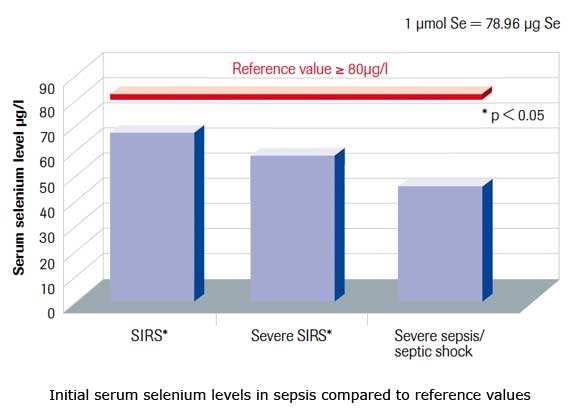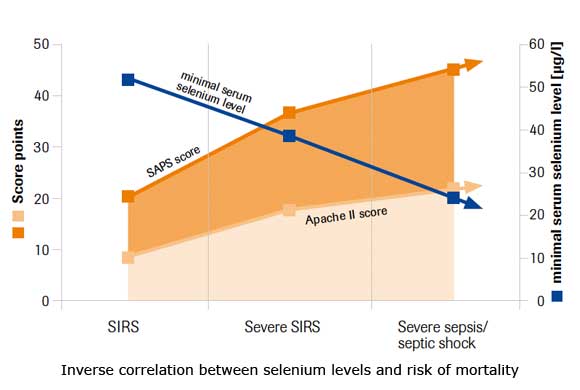Selenase® In Sepsis
Clinical Usage of Selenium For Deficiency in Sepsis
The annual incidence of patients faling ill from severe sepsis in the United States is estimated to be approximately 750,000; in Germany this figure is approximately 160,000. Taking Europe as a whole, however, the patient number is estimated to be also around 750,000. Death resulting from severe sepsis is between 30 – 50% of all cases.
There is usually an underlying disease such as cancer, acute pancreatitis, burns, multiple trauma, cranial and/or brain trauma, myocardial infarction. In the past 20 years the incidence of sepsis has risen five-fold because of the aging population and/or the number of patients with impaired immune system.
The exaggerated immune response/inflammatory reaction leads to characteristic haemodynamic changes, coagulation disturbances, tissue damage, multiple organ failure and ultimately to the death of the patient.
Sepsis/SIRS Patients Are Burdened By A Massive Load of Free Radicals And/Or Reactive Oxygen Species (ROS).

As studies show, the trace element selenium, essential for antioxidant defence, plays an important role here. Sepsis/SIRS patients already have very low selenium levels on admission to the intensive care unit (118, 131, 4). Their selenium levels are lower than those of intensive care patients without Sepsis/SIRS.
Inverse Correlation Between Selenium Levels and Risk of Mortality.
There is an inverse correlation between selenium levels and mortality risk as, predicted by SAPS (Simplified Acute Physiology Score), as well as the severity of sepsis. A low selenium level apparently means a worse prognosis.

This relationship is confirmed by the increased incidence of organ failure and nosocomial pneumonia with low selenium levels.
Clinical Studies
On this basis two prospective, randomised controlled clinical studies in sepsis/SIRS patients, independent of each other, were carried out in 1997. In both studies the initial selenium levels and the activity of the selenium dependent glutathione peroxidase were decreased greatly. [Zimmermann TH, Albrecht S, Kühne H, et al.: Selensubstitution bei Sepsispatienten. Eine prospektiv randomisierte Studie. Med. Klin 1997, 92 (Suppl.III) 3 – 4]
- Gärtner et al conducted a study in 42 internal medicine patients with an initial APACHE-II-score of > 15. All patients received standard supplementation with Addel® N, which contains 35 Microgram selenium per day. The 21 patients in the study group additionally received a bolus of 500 Microgram selenium as selenase® from day 1 to 3, then 250 Microgram selenium from day 4 to 6 and 125 Microgram selenium from day 7 to 9 as a continuous infusion with selenase®. The maximum total dose of selenium per patient over the 9 days was accordingly 3115 Microgram selenium as sodium selenite. The control group only received the standard supplementation with Addel® N. Compared to the control group, selenium levels and glutathione peroxidase activities normalised significantly in the study group. Concurrently there was a significant decrease in the APACHE-II Score with selenium therapy. In the study group 28-day mortality was 33 % as opposed to 52 % in the control group. Due to the low patient numbers these results were not significant. However in a subgroup analysis of severely ill patients (10 vs. 10) with an APACHE-II-Score > 20 a significant reduction in mortality from 70 % in the control group to 39 % in the study group was seen. A multi-centre Phase-III clinical study to investigate therapeutic efficacy and safety of selenase® was then carried out. [Gärtner R, Angstwurm MWA, Schottdorf J: Selensubstitution bei Sepsispatienten. Med Klinik 1997, 92 (Suppl.III) 12-14; Angstwurm MWA, Schottdorf J, Schopohl J, Gaertner R: Selenium replacement in patients with severe systemic inflammatory response syndrome improves clinical outcome. Critical Care Medicine 27 (1999) 1807-1813.]
- A meta-analysis of seven studies on the use of selenium in SIRS and sepsis has shown a positive trend with regard to reduction of mortality. Higher doses (1000 Microgram selenium as sodium selenite per day) had a more positive effect than low dose selenium. [Heyland DK, Dhaliwal R, Suchner U, Berger MM: Antioxidant nurtients: a systematic reviw of trade elements and vitamins in the critically ill patient. Intensive Care Med 31 (2003) 327-337]
